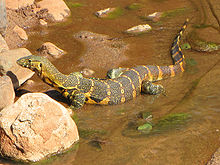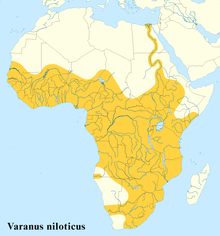- Nile monitor
-
Nile Monitor 
Lake Manyara, Tanzania Conservation status Scientific classification Kingdom: Animalia Phylum: Chordata Class: Reptilia Order: Squamata Suborder: Lacertilia Family: Varanidae Genus: Varanus Subgenus: V. (Polydaedalus) Species: V. niloticus Binomial name Varanus niloticus
(Linnaeus, 1758)
Nile Monitor range The Nile Monitor, Water Leguaan,[2] or River Leguaan (Varanus niloticus) is a large member of the monitor lizard family (Varanidae).
Nile Monitors can grow to about 9 ft (2.7 m) in length. They have muscular bodies, strong legs and powerful jaws. The teeth are sharp and pointed in juvenile animals and become blunt and peg-like in adults. They also possess sharp claws used for climbing, digging, defense, or tearing at their prey. Like all monitors they have a forked tongue, with highly developed olfactory properties.
Their nostrils are placed high on the snout, indicating that these animals are highly aquatic, but are also excellent climbers and quick runners on land. Nile Monitors feed on fish, snails, frogs, crocodile eggs and young, snakes, birds, small mammals, large insects, and carrion.
In South Africa they are commonly referred to as "leguaan," from the Dutch for iguana.
Range
Nile monitors are native to Africa and the species is distributed throughout the entire central and southern regions of the continent, including Sudan and a portion of central Egypt along the Nile river (Schleich et al., 1996; Spawls et al., 2002). They are not found in any of the desert regions of Africa, however, as they are excellent swimmers and thrive around rivers.[3][4]
In Florida, established breeding populations of Nile monitors are known to exist in different parts of the state since at least 1990 (Campbell, 2003; Enge et al. 2004). The vast majority of the established breeding population of the species is in Lee County, Florida, particularly in the Cape Coral and surrounding regions, including the nearby barrier islands (Sanibel, Captiva, and North Captiva), Pine Island, Fort Myers, and Punta Rassa. Established populations also exist in adjacent Charlotte County, especially in Gasparilla Island.[5] Areas with a sizeable number of Nile monitor sightings in Florida include Palm Beach County just southwest of West Palm Beach along State Road 80.[6] In July 2008 a Nile monitor was spotted in Homestead, a small city southwest of Miami. Other sightings have been reported near Hollywood, Naranja, and as far south as Key Largo in the Florida Keys.[7][8] The potential for the established population of Nile monitors in Lee, Charlotte, and other counties in Florida, to negatively impact indigenous crocodilians (American alligator "Alligator mississippiensis" and American crocodile "Crocodylus acutus") is enormous given that they normally raid crocodile nests, eat eggs, and prey on small crocodiles in Africa. Anecdotal evidence indicates a high rate of disappearance of domestic pets and feral cats in Cape Coral (Campbell, 2003).[9]
Captivity
Nile monitors require experienced care as pets and are not recommended for beginners; nevertheless they are often found in the pet trade.
Nile monitors need a very large cage, as they can reach lengths of over five feet in adulthood. Because of their large size, adults are likely to require custom-built quarters. Soil, sand, or bark chippings can be used as substrate. The enclosure should contain things to make a suitable habitat such as rocks, driftwood, plastic plants or hollow logs. A water dish large enough for the lizard to soak in should be used. Nile monitors have a tendency to defecate in the water dish, so clean it whenever soiled or at least daily.
Nile monitors should have a daytime temperature gradient of about 27–32 °C (81–90 °F) and a night time temperature of about 26–27 °C (79–81 °F). A basking spot of 60 °C (140 °F) should be provided at least 12 hours a day. A thermometer can be used to verify the temperature. The humidity should be moderate.
This species is very hardy in captivity when properly maintained. Wild caught animals should be checked for internal parasites. The Nile monitor has a very aggressive temperament with a powerful bite and a lashing tail and therefore is very dangerous. If raised with regular handling and a positive view of its keeper, a Nile Monitor can to some extent be tamed.
Albino (amelanistic) specimens have been found and propagated in captivity.
"There are few of these lizards less suited to life in captivity than the Nile monitor. Buffrenil (1992) considered that, when fighting for its life, a Nile Monitor was a more dangerous adversary than a crocodile of a similar size. Their care presents particular problems on account of the lizards' enormous size and lively dispositions. Very few of the people who buy brightly-coloured baby Nile Monitors can be aware that, within a couple of years, their purchase will have turned into an enormous, ferocious carnivore, quite capable of breaking the family cat's neck with a single snap and swallowing it whole."
(Bennett, D. 1995. Little Book of Monitor Lizards, Viper Press, Aberdeen, UK)References
- ^ IUCN Red List and search for Varanus niloticus
- ^ Varanus niloticus, The Reptile Database
- ^ Reptile Specialists (Nile monitor)
- ^ Varanus niloticus (Nile monitor) info
- ^ NAS - Invasive Species FactSheet
- ^ Everglades CISMA
- ^ Homestead Air Reserve Base home to diverse array of wildlife
- ^ Everglades CISMA
- ^ NAS - Invasive Species FactSheet
Varanoidea Extant species Argus monitor · Black tree monitor · Bengal monitor · Black-spotted Ridge-tailed Monitor · Crocodile monitor · Desert Monitor · Dumeril's monitor · Emerald tree monitor · Gray's monitor · Kalabeck's monitor · Kimberley Rock Monitor · Komodo dragon · Lace monitor · Mangrove monitor · Mertens' Water Monitor · Nile monitor · Peacock monitor · Peach Throat Monitor · Perentie · Rock monitor · Pilbara monitor · Rennell Island Monitor · Rosenberg's Monitor · Short-tailed monitor · Spiny-tailed monitor · Timor tree monitor · Turquoise monitor · Sand goanna · Savannah monitor · Water monitor · Yellow MonitorRelated categoriesMonitor lizards · Cretaceous lizards · Helodermas · MosasaursFossil species DolichosauridaeHelodermatidaeVaranidaeCategories:- Monitor lizards
- Reptiles of Africa
- Megafauna of Africa
- Invasive animal species in the United States
- Reptiles of Sierra Leone
Wikimedia Foundation. 2010.
